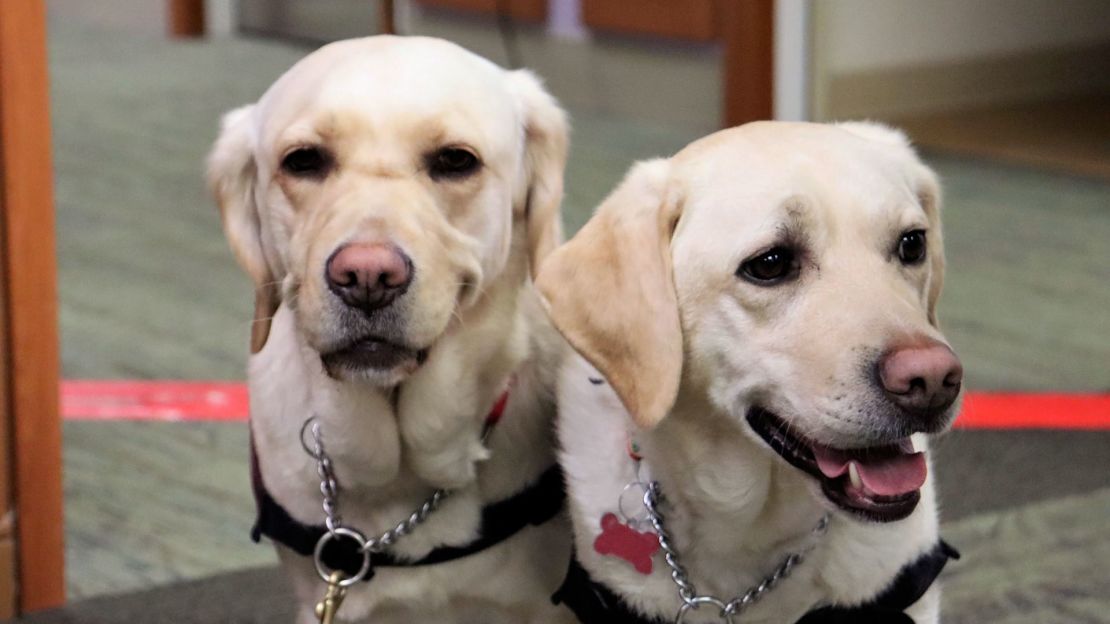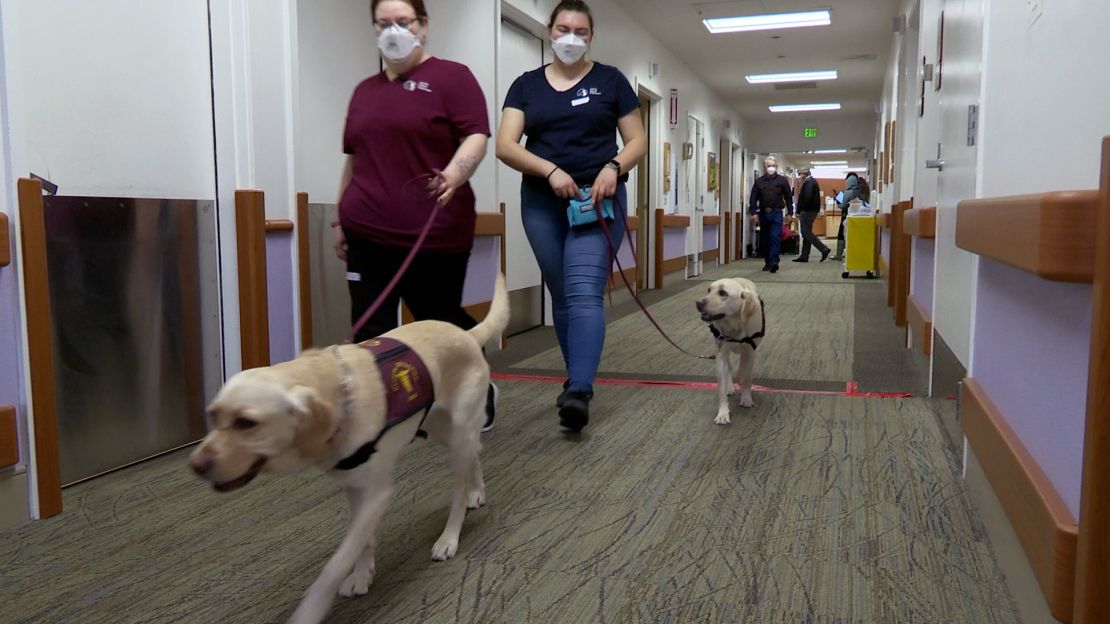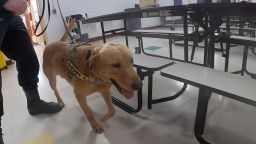Elementary students lined up behind a white curtain in the middle of a grand gymnasium at their school in northern California. They stood still as a dog handler walked a yellow Labrador along the other side of the curtain.
Hidden from the children’s view, the 2-year-old female pup sniffed each child’s shoes from beneath that curtain barrier. After each sniff, the dog looked back up at the handler. Then the handler brought the dog to the next tiny pair of feet beneath the curtain, and the dog curiously brought her snout close to those toes, then a young girl’s lavender tennis shoes and then another child’s white high-tops.
The dog was smelling for what are called volatile organic compounds that are known to be associated with Covid-19 infections.
While watching the Covid-sniffing dog in action, Dr. Carol Glaser saw her vision come to life.
Months prior, Glaser and her team were implementing the school’s Covid-19 testing program, using antigen nasal swab tests. Around that same time, Glaser heard about reports of dogs being used to screen for Covid-19 infections in sports venues, airports and other public settings.
That’s when Glaser had her “aha” moment – incorporating canines into Covid-19 testing programs at schools, nursing homes or other public facilities could help save time, personnel, possibly even costs, and “would be a lot more fun,” she said.
“I thought if we had dogs in schools to screen the students it would be so much faster and less burdensome for schools,” said Glaser, assistant deputy director in Central Laboratory Services and medical officer for infectious disease laboratories at the California Department of Public Health.
“Remember when an antigen test is done at school, as opposed to home, there’s a whole bunch of rules and regulations that run under that. It’s not as simple as just handing those things out at school and having the kids do them,” said Glaser, who oversaw antigen testing programs at some California public schools.
For now, Glaser and her colleagues described in a new study the lessons they learned from the Covid-19 dog screening pilot program that they launched in some California K-12 public schools.
In their research, published Monday in the journal JAMA Pediatrics, they wrote that the goal was to use dogs for screening and only use antigen tests on people whom the dogs screened as positive – ultimately reducing the volume of antigen tests performed by about 85%.
They wrote that their study supports the “use of dogs for efficient and noninvasive” Covid-19 screening and “could be used for other pathogens.”
Letting the dogs out for screening
The dogs used in the pilot program – two yellow Labradors named Rizzo and Scarlett – trained for a couple of months in a laboratory, sniffing donated socks that were worn by people who either had Covid-19 or didn’t. The dogs alerted their handlers when they detected socks that had traces of the disease – and received a reward of either Cheerios or liver treats.

“The one thing we do know for sure is when you’re collecting a sample off of a human being, you want to go where the most scent is produced. That is the head, the pits, the groin and the feet. Given those options, I went with feet,” said Carol Edwards, an author of the study and executive director of the nonprofit Early Alert Canines, which trains medical alert service dogs, including Rizzo and Scarlett.
“We collected some socks from people willing to donate socks, and we taught the dogs, by smelling the socks, which ones were the Covid socks and they picked it up very quickly,” Edwards said. “Then we moved into the schools and started sniffing the kids at the ankles.”
Last year, from April to May, the dogs visited 27 schools across California to screen for Covid-19 in the real world. They completed more than 3,500 screenings.
Rizzo acted as an energized worker, performing tasks with eagerness, Edwards said, while Scarlett tended to have more of a mellow and easygoing personality.
The screening process involves people – who voluntarily opted in to participate – standing 6 feet apart while the dogs, led by handlers, sniff each person’s ankles and feet. The dogs are trained to sit as a way of alerting their handlers that they detect a potential Covid-19 infection.
To protect each person’s privacy, sometimes the people face away from the dogs and toward a wall or behind a curtain, so that they can’t see the dogs or when a dog sits. If the dog sits in between two people, the handler will verbally ask the dog, “Show me?” And the dog will move its snout to point toward the correct person.
“Our dogs can come in, they can screen 100 kids in a half hour, and then only the ones the dog alerts on have to actually do a test,” Edwards said. “There’s no invasive nasal swab unless the dog happens to indicate on you.”
The researchers found that the dogs accurately alerted their handlers to 85 infections and ruled out 3,411 infections, resulting in an overall accuracy of 90%.
However, the dogs inaccurately alerted their handlers to infections in 383 instances and missed 18 infections, which means the dogs demonstrated 83% sensitivity and 90% specificity when it came to detecting Covid-19 infections in the study.
“Once we stepped into the schools, we saw a drop in their specificity and sensitivity due to the change,” Edwards said, referring to the distractions that children in a school setting can bring. However, Edward said, accuracy improved as the dogs spent more times in schools.
In comparison, Covid-19 BinaxNOW antigen tests have been shown in one real-world study to demonstrate 93.3% sensitivity and 99.9% specificity. That study was conducted in San Francisco and published in 2021 in The Journal of Infectious Diseases.
“We never said the dogs will replace the antigen. This was a time for us to learn how they compared,” Glaser said. “We will always plan on doing some amount of backup testing, but the idea would be that the actual antigen testing would be a fraction of what it would currently be because of the dogs.”
“To run these antigen testing programs at school, it’s taking a lot of school personnel resources, test cards as well as biohazard waste. So, I have no doubt in the long-run once it can be perfected, dogs will be cheaper, but I don’t have a great cost comparison,” she said.
This isn’t the first time that dogs’ abilities to detect traces of Covid-19 infections in real-time have been studied in the scientific literature.
“What we have learned in this work is that the dogs in general are capable of discriminating samples from individuals testing,” said Dr. Cindy Otto, professor and director of the Penn Vet Working Dog Center at the University of Pennsylvania, who was not involved in the new study.
Regarding the new research, Otto said, “On the surface their results are encouraging and with the appropriate selection of dogs, rigorous training and impeccable quality control, there is the potential for dogs to be incorporated in threat monitoring.”
Nursing homes could be next
Now that Glaser and her colleagues have published research about their Covid-19 dog screening pilot program, she is eager to implement the approach in nursing home settings.
“Honestly, schools aren’t that interested in testing anymore. The outbreaks just aren’t what they used to be, but what we have done is we’ve transitioned to nursing homes, because there is a tremendous need in nursing homes,” Glaser said, adding that many residents may prefer to undergo screening with a dog than with uncomfortable nasal swabs. “What would you rather have: A swab in your nose or something that just maybe tickles your ankle at most for testing?”

In skilled nursing homes, the dogs visit each resident’s room to sniff their feet, calmly smelling for Covid-19 volatile organic compounds as the resident lies in bed or sits in a chair.
“Thinking about where dogs would be deployed, I do really think nursing homes and residential care facilities and even schools – if they were ever to have a big outbreak – would be the natural next fit for this,” Glaser said.
“We think we’ll probably end up primarily using them in nursing homes,” she said. “But we’re still doing a little bit of both – there was a school that asked us to come back last week.”
Get CNN Health's weekly newsletter
Sign up here to get The Results Are In with Dr. Sanjay Gupta every Tuesday from the CNN Health team.
The pilot program within California public schools also has left Edwards with hope for future opportunities in which canines can help detect disease in humans.
“I really do think it’s the tip of the iceberg. This is the door swinging wide open, and now we need to collaborate with those in the science world and figure out where we can take this,” Edwards said.
“There’s been a lot of chatter, even in the very beginning of this project, talking about what other diseases they could do. We’ve talked about TB, we’ve talked about flu A and B, possibly for this next flu season, seeing if we can get the dogs to alert on that,” she said, as volatile organic compounds are also produced by people with influenza. “It’s just a matter of being able to figure out how to collect samples, how to train the dogs, and then to be safe and effective around those diseases too.”




